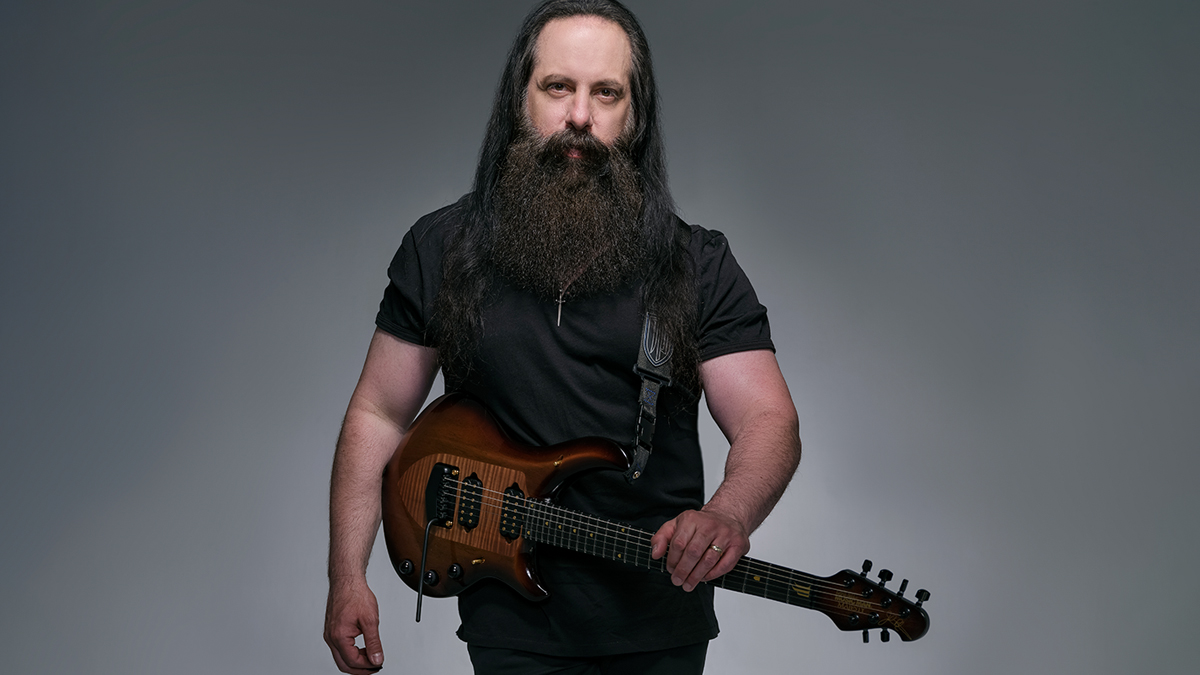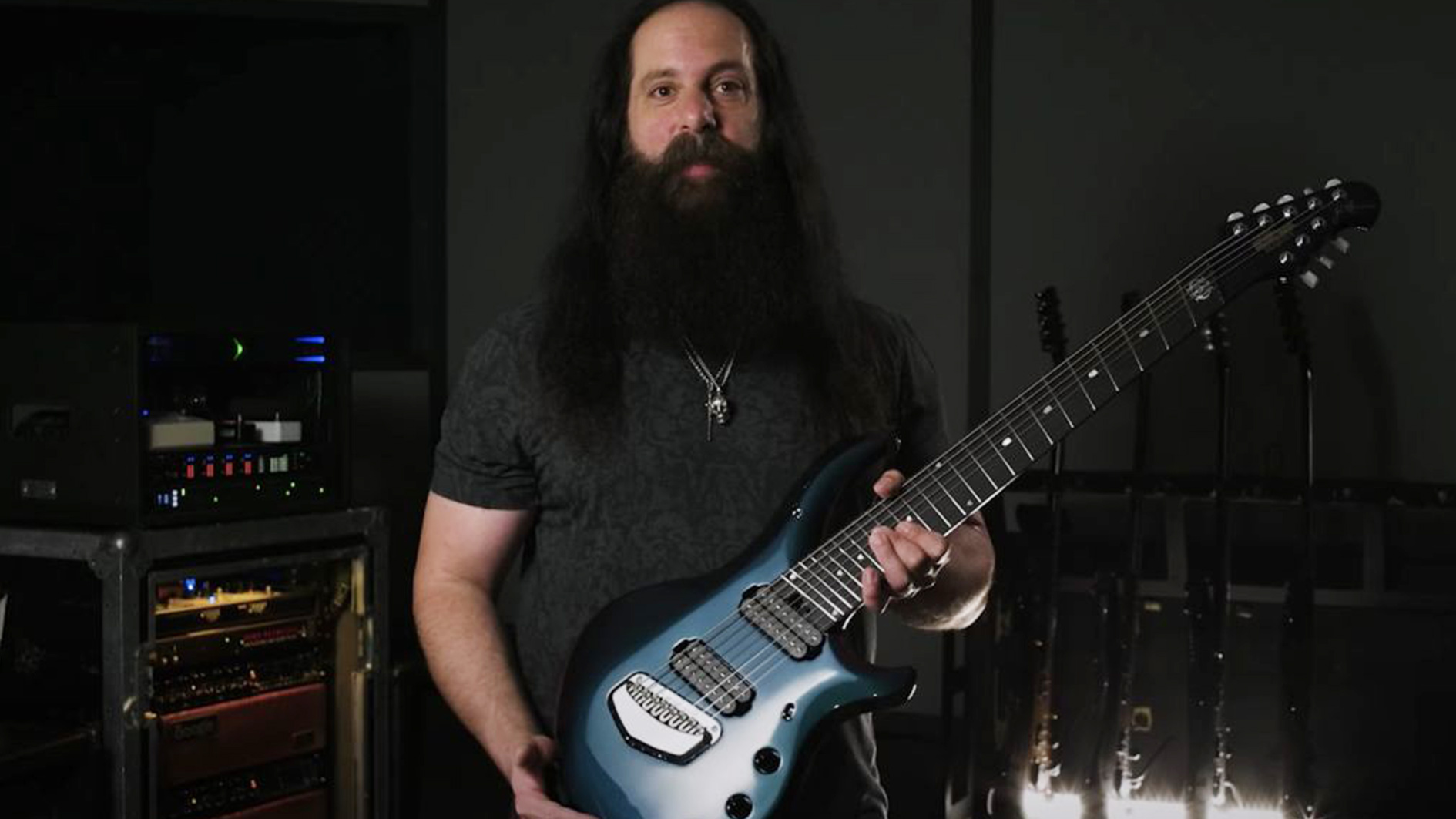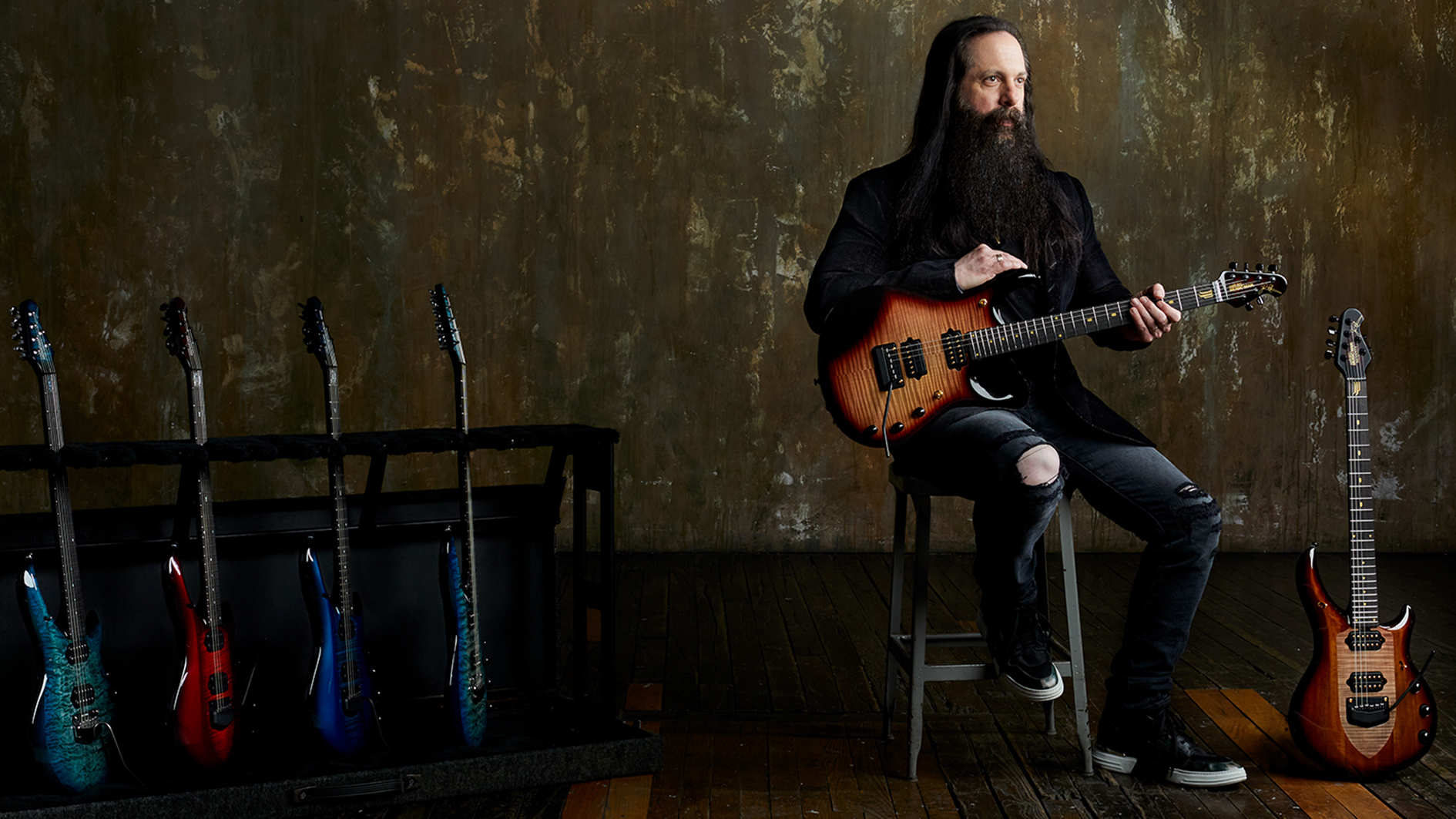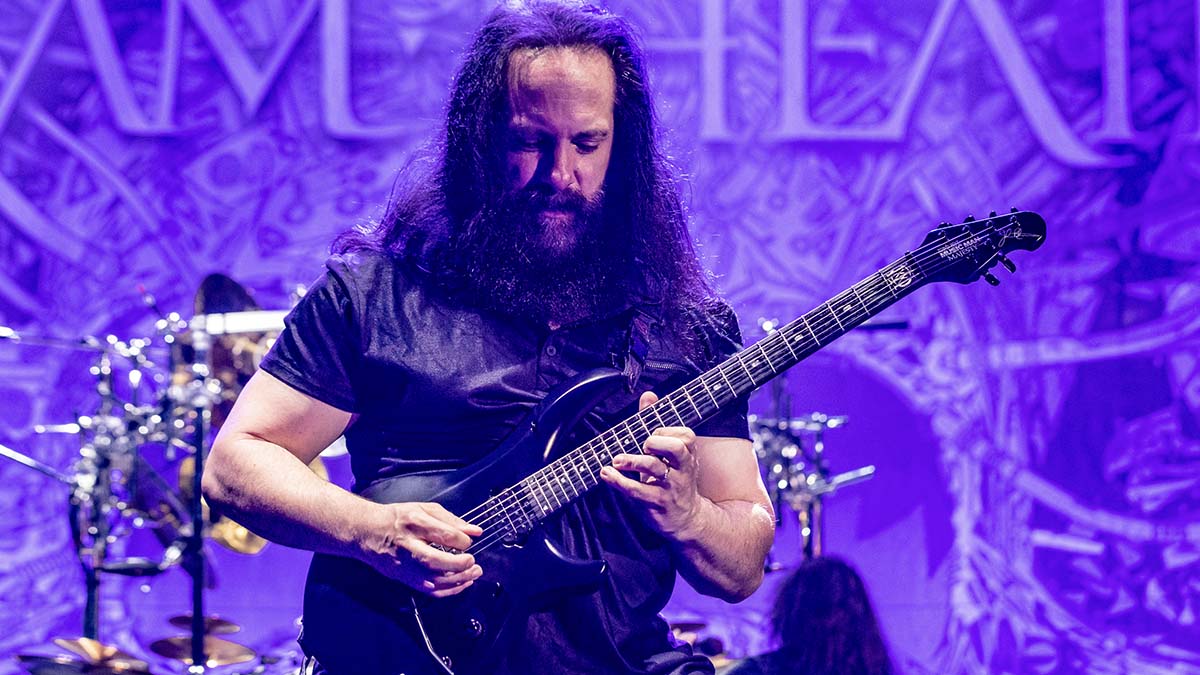John Petrucci: “When you solo, you’re the vocalist in the band... In that way, I’ve always been influenced by guys like David Gilmour, Neal Schon and Gary Moore”

For John Petrucci the question isn’t so much, “What did you do during the pandemic?” Rather, it’s “What didn’t you do?” Ever since global lockdowns kept musicians of every stripe off the road for much of 2020 and well into this year, the Dream Theater guitarist has been busier and more prolific than ever.
He wrote, recorded and released his second solo album, Terminal Velocity; soon after, he got together with his Liquid Tension Experiment supergroup members (bassist Tony Levin, Dream Theater keyboardist Jordan Rudess and former DT drummer Mike Portnoy) to bang out Liquid Tension Experiment 3, their first record in 22 years.
The guitarist also partnered with Iron Smoke Distillery to introduce his first signature bourbon whiskey (Rock the Barrel), and he even came out with his own brand of grooming products. Yes, you read that right: Petrucci’s Nebula line, developed in collaboration with Captain Fawcett, includes beard balm, beard oil and mustache wax.
Between work, whiskey and hair care, has he had time for anything else? “Oh, sure,” he says. “Like everybody else, we’ve been watching a bunch of Netflix. There’s so many good shows nowadays, although we did recently rewatch The Sopranos. That was a lot of fun.” He admits the past year and a half hasn’t been without its challenges.
In fact, Dream Theater were deep into a world tour that was slated to stretch to the end of 2020 when they were forced to cancel the remainder of their dates.
“For us, the economics of staying off the road were no small thing,” Petrucci says. “Our livelihoods come from touring. We established that years ago, because we’re not the kind of band that relies on massive record sales and radio hits. While we’re fortunate to have that loyal fan base that comes to our shows, to see that suddenly shut down was pretty tough.”
Not only did the band (which also includes Rudess, singer James LaBrie, bassist John Myung and drummer Mike Mangini) have to worry about their own hides, but they also had to consider how to keep their touring crew intact. “It wasn’t like other years where they could jump on another tour to stay afloat,” Petrucci says. “There were no tours out there at all. The entire business was shut down.”
Get The Pick Newsletter
All the latest guitar news, interviews, lessons, reviews, deals and more, direct to your inbox!
In an effort to support their crew, the band recorded a medley of Christmas classics called The Holiday Spirit Lives On and released the track on Bandcamp, with all proceeds going to their touring personnel. “Thankfully, everybody was able to get some money from that,” he says. “And what’s great is that we were able to hold on to everybody who works for us. They’re all coming back when we go out and tour again.”
Oh, yes, Petrucci did manage to squeeze another project into his bursting schedule – a new Dream Theater album titled A View from the Top of the World. It’s the band’s 15th full-length studio record and the first disc they recorded at their brand-new, Long-Island-based facility (combination recording studio, rehearsal space, equipment storage and creative hangout) called Dream Theater HQ.
On previous albums, Petrucci, who also operates as the band’s producer, would usually bring in fleshed-out demos created either by himself or in partnership with Rudess. And even if he didn’t have full demos, he would invariably have something up his sleeve – even stray riff ideas he’d recorded into his phone. This time, however, he went into the studio totally cold.
“It was a little frightening for me at first,” he says. “Because I had written so much music, what with my solo record and Liquid Tension, I thought, ‘I hope I don’t run out of ideas.’ Thankfully, that didn’t happen. Everybody was so charged up and happy to be in the studio for the first time in a while. The ideas started flying around right away, and we were off to the races.”
Because of COVID protocols, recording the album was a far different undertaking from past go-arounds. The band members wore masks in the studio for a time, and the group’s studio manager, Maddi Schieferstein (who also doubles as Petrucci’s guitar tech) had Plexiglas partitions and an air-filtration system installed.
“We were very safe,” Petrucci says. “Nobody was traveling, and we had our hand sanitizers. After a while, we all got tested and the masks came off. Everybody was fine, and nobody got sick.”
I think this record really encapsulates what Dream Theater is about
As he resides in Canada, singer LaBrie, however, was unable to travel to the States at the time, so he joined his bandmates in the studio, for both writing and tracking sessions, from his own home studio via Zoom.
“We had a big TV monitor in our live room, so James was basically right with us, listening and commenting, the whole time,” Petrucci says. He points out that the first new song the band wrote together, The Alien, a nine-minute crusher that features one daredevil riff after another, was partly inspired by the peculiar circumstances they found themselves in.
“Everything felt a bit odd at first, how we were coming together after being apart for so long. I think that song really speaks to our collective frame of mind: ‘Here we are. Everything feels new again. OK, let’s make some music!’”
Indeed, there’s a palpable sense of discovery throughout A View from the Top of the World. Nothing feels overcalculated – there are no extended storylines; each song is its own free-floating vehicle – and the music comes at you in spontaneous, exuberant bursts.
On the lowdown grinder Awaken the Master, Petrucci, playing an eight-string guitar for the first time, sounds as if he’s having a wickedly good time coaxing monstrous rasps and roars from the instrument during the song’s hair-raising solo section. And on the similarly angsty Invisible Monster, he changes the mood abruptly – almost at random – peeling off deliciously smooth and supple leads that lend a lighthearted, freewheeling contrast to the song’s ominous air.
Transcending Time, a hook-filled tip of the hat to '80s-era Rush, offers the guitarist another opportunity to go far and wide, and he takes off rapturously, filling the air with spiraling double-tracked lines that glisten with radiant beauty.
What can one say about the extravagant, 20-minute album-closing title track? Summersault riffs, gargantuan rhythms, odd-time volleys, guitar-and-keyboard unison frenzy, a few more riffs, and more Petrucci standout solos than any song has a true right to bear – it’s instrumental grandeur in Cinemascope view. Call it the Lawrence of Arabia of Dream Theater pieces.
“I think this record really encapsulates what Dream Theater is about,” Petrucci says. “To me, it reaches back to our roots in a lot of ways, but it also incorporates some of the new stuff we’ve learned and developed in our career. I think you can really hear how high our energy level was at all times.
“This is a band that really values being able to play our instruments, but we also just love being together. Like everybody else, we had that taken away from us for a while, so to get that back and be able to do what we do, we treated it like a celebration. I think that really comes across on the record.”
Normally, you would have toured quite a bit during the past year and a half. By being home so much, are you a better player? I have to imagine you’ve had more time to practice.
“A lot more time, sure. In some ways I’m a better player. Being at home and practicing has certainly improved my chops and skills – no question about it. Along with that, there’s recording and being in the studio, which requires a high level of concentrated playing for hours a day. I’ve been doing that since March 2020, so it’s really kept me on my game.
“Here’s the interesting part. Even with all the home and studio practicing I’ve been doing, there’s nothing that brings you to a high level like playing in front of people. At the camp I did recently, I played a concert at the end, and it was amazing how different it felt – the energy level. You can practice all you want at home, but performing before an audience is a whole different ball game. It’s as if you use different muscles.”

How is the finished album different from what you initially envisioned? Even though you went into the writing cold, did you have any preconceptions about what it would be?
“I did have some preconceptions going in. I wanted to do things more stripped down as far as the production. I always double track guitars, and I thought, ‘Maybe I’ll single track guitars and really make it sound like we’re playing live.’ And… that sort of went out the window. [Laughs]
"Once we got together and started writing, I went back to doing things as I normally do, double tracking guitars and really producing the music. That’s just the way I am.”
I heard an interview with former Major League Baseball pitcher CC Sabathia, and he said something interesting. He said it was too big for him to think about winning the World Series, so he approached each game just trying to win inning by inning. Is making a record the same kind of thing? You just try to make each moment count?
“That is interesting. What you’re talking about and what he said reminds me more of developing skill and craft on the guitar. I hear from people all the time who get overwhelmed about guitar playing; they have skill, but they just don’t know how to tackle everything all at once. Which, of course, you can’t do. Once you break everything down into small pieces and you realize everything comes from each piece, you gain knowledge easier and can expand on it.
“I can relate to what CC was saying. When we’re making a record, I do like to have a bigger picture in mind because it kind of helps get the whole band on the same page, as opposed to just sort of going on with no direction. But having said that, when we’re writing and recording, I want to make sure each section is meaningful. Make each moment count.
“Those moments become songs, and songs become an album. I try to remember that stuff, but it’s so easy to get caught in the weeds, especially for me because I’m producing. I have to change hats all the time: ‘Are we achieving our goal? How do we need to adjust? Is this coming out the way we envisioned it sounding?’ It comes with the territory, I guess.”

You’ve been producing for a while. Do you look back at when you started and go, ‘Man, I really didn’t know anything about record making back then’?
“In some ways, sure. I started producing with [1999’s] Scenes from a Memory. Mike Portnoy and I did that as a partnership, which we continued until he left the band. At that point, I started producing our records myself. I admit I had a lot to learn. There was a lot of responsibility on my shoulders. Between all the records we’ve done since then, I’ve grown a lot. You can’t help but learn. You learn from your mistakes and what you should have done differently.”
What’s an example of a mistake you used to make?
“I would say I didn’t always listen to people when they would bring up certain ideas or concerns. When you’re producing, you’re steering the ship, but you have to be careful not to be close-minded. If somebody brings up something, you can’t just shut them down. James might say, ‘The mix sounds good, but the drums are a little too processed.’ And I might be like, ‘No, they don’t. They sound great.’
With guitarists, you need to focus on specifics – how your fingers are moving, picking angle, conserving motion. It sounds all nerdy, but it works. Guitar playing and weight lifting are very related in my book
“You almost get defensive because you’ve put so much work into it. Or Mike might say, ‘You know this is really good, but I feel like there’s too many ballads.’ My gut response might be to disagree, but I can’t be dismissive. I have to listen to those comments because they’re not in it as deep as I am.
“And, of course, they might be right. They might be right. So I’ve learned to really listen to the guys and have an open mind. A good example on the new record is when Mike said, ‘There’s a lot of energy on the record, but we didn’t do a ballad. I feel like we need a mid-tempo kind of song.’
“Instead of saying, ‘I don’t think so,’ I said, ‘Let’s try it.’ We ended up writing Invisible Monster, and it’s one of the coolest songs on the record. It’s important to maybe have the last word and steer the ship, but it’s also important to really listen to people, because they might be right and you might learn something.”
I have another sports-analogy question. You’re into weight lifting, and you also play the guitar a bit.
“[Laughs] Yeah, a little bit.”
Is there any correlation between the two? For your level of playing, you need stamina and dedication. The same is true for weight lifting.
“Absolutely. I’ve always felt as though there was a connection between them. Of the two things that stand out, one of them is consistency. People who become proficient on their instruments or get in really great shape are doing so because they practice or work out on a regular basis. Whether it’s every day or four or five days a week, you can’t get there by being a weekend warrior. It doesn’t work that way. You need to be consistent to achieve gains and see results.
“The second thing is form. You see it with guitar players who have really great technique – or bodybuilders who are in fantastic physical shape. If you’re lifting weights, you can’t just throw stuff around willy-nilly; you need to work out with structure and discipline. You need a plan. With guitarists, you need to focus on specifics – how your fingers are moving, picking angle, conserving motion. It sounds all nerdy, but it works. Guitar playing and weight lifting are very related in my book.”
Let’s get into some of the new songs. The Alien is fast paced and has a lot of super-charged riffs, but also there are some beautiful moments of David Gilmour-esque lead lines. You like that contrast, don’t you?
“Sure. I love mixing the two approaches. You know, the guitar is such a beautiful and expressive instrument. It allows you to be the melody cat in so many ways. When you solo, you’re the vocalist in the band for those moments. In that way, I’ve always been influenced by guys like David Gilmour, Neal Schon and Gary Moore. They’re phenomenal at that kind of thing. You hear it on the album.
“If a song is really energetic and has a lot of riffs, I put in the contrast of a beautiful melodic section. That side comes out in The Alien and Awaken the Master. That juxtaposition has always been very important to me.
“I’ll give you my own analogy: If we were in a speedboat going full bore for a while, sometimes it’s nice to slow down and just admire the water. We would look at the scenery, the mountains; we’d just take a moment to breathe. That’s what those melody sections do. I love how the guitar allows you to experience those contrasts.”

Sleeping Giant has an extended solo section in which you and Jordan really go at it. You shift moods and sounds, and there’s even a part where he plays a wild honky-tonk piano solo. How do you guys work that out? Do you reject as many ideas as you keep?
“A lot of it is improvisation. I think what we do is allow each other to shine. We love trading solos and playing unison lines, and we have fun trying new things sonically. The great thing about our style of music is, we have the freedom to do that to the fullest extent. We’re not confined by song length or stylistic preconceptions. We shred and solo and improvise.
“We can kind of do whatever we want. It’s very stream-of-consciousness, but it’s also very mapped out. A lot of times, it’s like, ‘You take the first solo. Then I’ll come in, and then you’ll come back. Then at the end, we’ll do a unison thing.’ It’s great. Everybody gets involved and has a chance to shine. We do that with all the instruments: ‘Mike, this is your part. You go for it. This is going to be a great drum moment.’ It’s really just having fun with the music.”
You mentioned Awaken the Master before. You’re using an eight-string guitar for the first time on that one.
“I’m really excited about this. Throughout my 20 years with Ernie Ball Music Man, we’ve done six- and seven-string models, but never an eight-string. I’ve never even played an eight-string before, but I wanted to develop one and actually get into the studio and write a song on it. The timing never worked out till earlier this year. I got a prototype and started playing it, and right away I wrote Awaken the Master with the band.
“Just like it was with a seven-string, playing the eight-string felt like a cool new breakthrough. That extra string broadened the range of the instrument. Think of it as a keyboard player having more keys so he can go lower – that’s what it’s like with this guitar. Things like scales and arpeggios translate beautifully because their shapes stay the same; I don’t use any sort of weird tuning.
“With chords, you have to adjust and figure out how that added range is going to extend, but that came pretty quickly. There was a bit of learning how to work the sound a bit, but it’s been so much fun.”
So now we come to the title track – over 20 minutes of music.
“[Laughs] We did that on purpose. We had to scratch the itch of creating an epic, because on Distance Over Time the song lengths were a bit shorter than what we normally do. This time, we went in and said, ‘We’re going to write this song, and we don’t care how long it’ll be; in fact, it’ll probably be at least 20 minutes.’
“It’s a great feeling writing an intro and knowing it doesn’t have to be over in 15 seconds. It can be three minutes, five minutes – it’s part of a bigger picture. From there, you start to see the song take shape before your eyes. At a certain point, you know how it’ll end, but you have to figure out how to get there. As you see your way to the end, you get into recurring themes and melodies. Because there are no ballads on the album, we brought things down a bit in the middle.
“It’s a big, epic story, and you can’t just be full bore for 20 minutes. There has to be some ebb and flow. I love that middle section, with the cello solo and how we bring things down to almost a very Floyd-like way.
“The other part is making sure there are enough vocal sections in which you can tell a story, but before that you need to have a big enough concept where lyrically that story will be appropriate for such a long song. After you have that down, you finally say, ‘There’s going to be a lot of moments where we can really go for it.’ Whether that’s trading solos or crazy instrumental parts, it’s no-holds-barred.”
It’s one thing to record a 20-minute song – you can always track parts in sections. Playing it live is different.
“People are always curious about that. Obviously, we rehearse a lot. There’s nothing like going over something again and again to help you get the stuff dug in. But you also need to know the roadmap of the song and where a section is leading; that gives me the signal for the next part that’s coming up.
“Sometimes it happens rhythmically. There might be a drum fill or a rhythmic figure that sparks my memory. But there’s no substitute for playing a song over and over before a tour. It’s repetition. If I were driving from New York to Boston right now, I wouldn’t need a map because I’ve made that drive a bunch of times. I know how to get there. I don’t need to know every little detail along the way; I know the general roadmap.”
Guitar-wise, did you record the whole album with your Majesty models?
“Yep. The Ernie Ball Music Man Majesty. I used the Purple Nebula, which is just a beautiful-sounding guitar. For the seven-string stuff, I used my Ember Glow Majesty 7, and on Awaken the Master I was playing the prototype of the eight-string. I might have done some layering on Sleeping Giant with the eight-string. The acoustic stuff was done on a Taylor Builder’s Edition.”

I imagine you didn’t stray from your signature Mesa/Boogie amps…
“I’ve used my signature Mesa/Boogie JP-2Cs since they were made. That’s the amp. It sits there, we mic it up, I plug in, and there’s my sound. It’s great not having to search for different amps anymore. There’s a real comfort in always knowing you’re going to sound great. That amp never lets me down.
“I do use a few pedals: a Darkglass compressor, some Boss Waza Craft pedals and, of course, I always use my signature Dunlop JP95 wah and my TC Electronic Dreamscape pedals. I have fun making cool sounds with them.”
Do you have a favorite guitar moment on the record?
“One of my favorite moments is in the intro to Sleeping Giant, when the first guitar comes in on the left side. That’s the sound I get when I plug the Majesty into my JP-2C. You hear me play the riff, and it’s really raw on one side. I love that. It’s like my quintessential sound. I hear that and I’m like, ‘Yeah, that’s the shit!’”
- A View from the Top of the World is out now via Inside Out Music.
Joe is a freelance journalist who has, over the past few decades, interviewed hundreds of guitarists for Guitar World, Guitar Player, MusicRadar and Classic Rock. He is also a former editor of Guitar World, contributing writer for Guitar Aficionado and VP of A&R for Island Records. He’s an enthusiastic guitarist, but he’s nowhere near the likes of the people he interviews. Surprisingly, his skills are more suited to the drums. If you need a drummer for your Beatles tribute band, look him up.
“His songs are timeless, you can’t tell if they were written in the 1400s or now”: Michael Hurley, guitarist and singer/songwriter known as the ‘Godfather of freak folk,’ dies at 83
“The future is pretty bright”: Norman's Rare Guitars has unearthed another future blues great – and the 15-year-old guitar star has already jammed with Michael Lemmo










